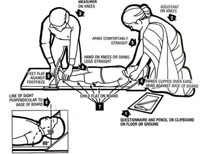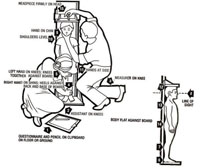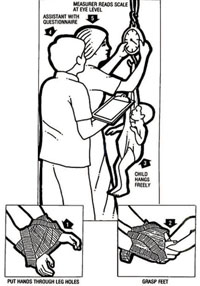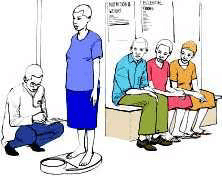Nutritional assessment is the process of estimating the nutritional status of an individual or group at a given point in time by using different assessment method. Its purpose is to determine the nutritional status of an individual or a community and helps to monitor trends in the change of nutritional status over time. It also helps to monitor the effectiveness of nutritional intervention so as to consider options accordingly. There are four different methods to collect nutritional information:
a. Anthropometric measurement
b. Clinical assessment
c. Biochemical assessment
d. Dietary assessment
Anthropometric measurement
This is the measurement of the various physical dimensions and the gross compositions of the individual body at different age levels and status of nutrition. Anthropometric assessment is done for two purposes, i.e. measurements of growth, and body composition.
Length
Length is measured by using a wooden measuring board (also called sliding board). It is used for measuring the length of children less than two years old to the nearest millimetre. Measuring the child lying down always gives readings greater than the child‘s actual height by 1-2 cm.
Procedure:
- Greet the mother ( caregiver ).
- Explain the mother ( caregiver) what you are going to do for the child.
- Collect the necessary material for the measurement.
- Find assistant to help you to measure a child using this method.
- Both assistant and measurer are on their knees.
- The assistant holds the child‘s head with both hands and makes sure that the head touches the base of the board.
- The assistant‘s arms should be comfortably straight.
- The line of sight of the child should be perpendicular to the base of the board (looking straight upwards).
- The child should lie flat on the board.
- The measurer should place their hands on the child‘s knees or shins.
- The child‘s foot should be flat against the foot piece.
- Read the length of the tape attached to the board.
- Record the measurement on the questionnaire.

Figure 3.1: - Measuring length, (source UNICEF1986, how to weigh and measure children: assessing the nutritional status of young children).
Height
This measurement is taken in a standing position for children who are 2 or more years old and for adults. The position of the client should be Frankfurt (where the line passing through the external ear hole to the lower eyelid and parallel to the floor) during measurement, the client's shoulders, buttocks and the heels should touch the vertical stand. Either a stadiometer or a portable anthropometry can be used for measuring. Measurements are recorded to the nearest millimetre.
Procedure
- Greet the mother if the measurement is done for the child.
- Explain the procedure to the mother what you are going to do for the child.
- Collect all necessary materials for the measurement.
- To measure a child‘s height, you need assistance.
- Both the assistant and measurer should be on their knees.
- The right hand of the assistant should be on the shins of the child against the base of the board.
- The left hand of the assistant should be on the knees of the child to keep them close to the board.
- The heel, the calf, buttocks, shoulder and occipital prominence (Prominent area on the back of the head) should be flat against the board.
- The child should be looking straight ahead.
- The hands of the child should be by their side.
- The measurer‘s left hand should be on the child‘s chin.
- The child‘s shoulders should be levelled.
- The headpiece should be placed firmly on the child‘s head.
- Record the measurement on the recording form.

Figure 3.2. Measuring the height. (Source UNICEF, 1986, how to measure children: assessing the nutritional status of young children).
Weight
The weight of children under two years old is measured by spring balance or Salter Scale, for adults and children over two years old a beam balance is used. The measurement is also to the nearest 0.1 kg for both measurements.
Procedures
- Greet the client if an adult or the caregiver if the client is a child.
- Explain what you are going to do for the client.
- Collect the necessary materials for the measurement.
- Adjust the pointer of the scale to zero level.
- Take off the child‘s heavy clothes and shoes.
- Hold the child‘s legs through the leg holes.
- Hold the child‘s feet.
- Hang the child on the Salter Scale.
- Read the scale at eye level to the nearest 0.1 kg.
- Remove the child slowly and safely.
- Record the measurement on the recording form.

Figure 8. Measuring of weight with the slanted scale
Measuring Weight for Adults
Procedures:
- Explain the procedure to the client as you are going to weigh him / her
- Choose appropriate beam balance since they are an adult.
- Ask the person to take off shoes and extra clothes.
- Ask the person to stand straight in the centre of the balance platform.
- If the person cannot stand without help, take MUAC).
- Read the weight as soon as the indicator on the scale has stabilised.
- Make sure the weighing scale is calibrated to zero before each measurement is taken.
- Record the weight to the recording form.

Figure 9. Measurement of adult weight




